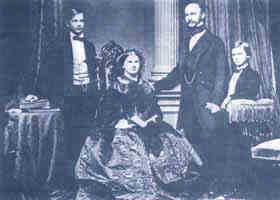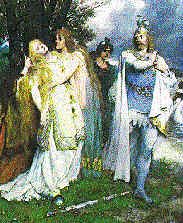![]()
 |
King Ludwig II of Bavaria was born in Nymphenburg Castle outside Munich in the early hours of August 25, 1845. He was the eldest son of King Maximillian II and Queen Marie, and was named after his grandfather, King Ludwig I.
Ludwig's Childhood
As a boy, Ludwig was given a typical 19th cent. upbringing - an indifferent father and schooling which consisted of constant beatings. It is fairly obvious that he would have been miserable as a child. His favourite times of the year were the summer holidays the family spent at the Royal Castle Hohenschwangau which King Max had restored between 1832 and 1836 in a romantic medieval style. Hohenschwangau's position can only be called magnificent; it is situated beside a blue alpine lake, the Alpsee, and about 2 kilometres from the Austrian border and the Tyrolean Alps.
 |
The Royal Family in 1862. Left to right, Ludwig, Queen Marie, King Max II, Otto.
The Queen enjoyed taking Ludwig and his younger brother Otto on lengthy hikes in the nearby alps and it would have been on these occasions that Ludwig developed his love of the mountains and their solitude, as well as his lifelong devotion to the Schwangau region. He also loved to feed the wild swans that lived around the lake, and several drawings of swans that he made at this time survive today.
The discovery of Wagner
In 1858, when Ludwig was thirteen years old, his governess told him of the upcoming production of Richard Wagner's opera Lohengrin, the story of which centres around the heroic medieval Swan-knight Lohengrin. Since the walls of Hohenschwangau were covered in frescoes featuring Lohengrin, a curious Ludwig acquired a copy of the opera's libretto and he read it voraciously. It wasn't too long before the Prince had learnt the entire libretto off by heart, as well as the libretto of another Wagner opera, Tannhäuser. He was soon devouring every book written by Wagner, and on February 2nd, 1861, Ludwig heard a Wagner opera for the first time.
 |
Lohengrin, the Knight of the Swan, reveals his identity to the people of Antwerp at the dramatic climax of "Lohengrin".
Appropriately it was Lohengrin and the experience left a profound impression on the Prince. In 1863 he acquired Wagner's recently published Ring Cycle, the preface of which contained a comment about the miserable state of the German theatre. In order for the Ring to be produced, Wagner wrote, a German Prince would need to be found to provide the required funds. To Ludwig, this was a direct message from the master. He would be that Prince.